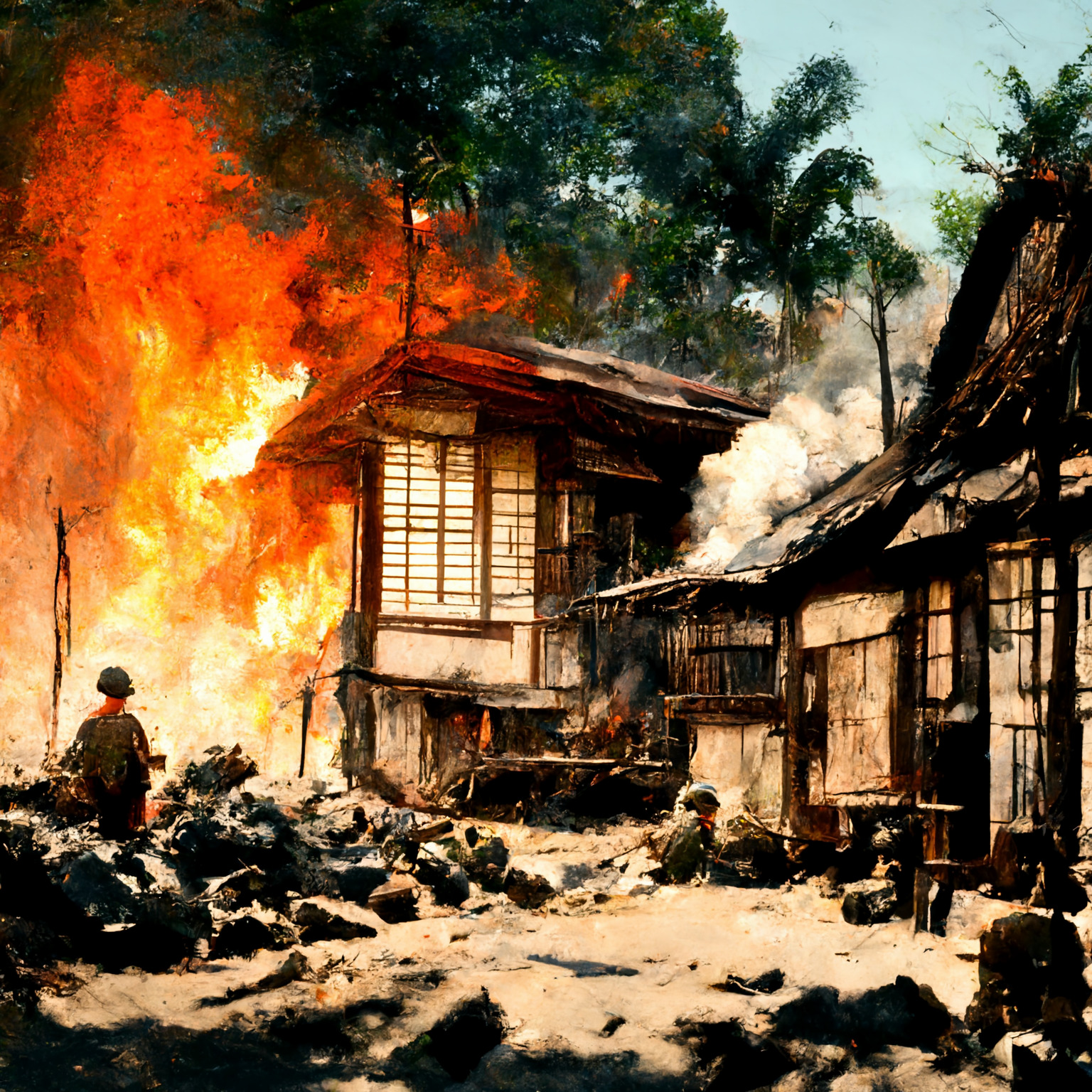The article about the Agdangan massacre was written in 1983 as a painful reminder of the atrocities of the second world war. The Shin guntō (new military sword) was the weapon and symbol of rank of the Japanese Imperial Army.
By: Nellie Atos-Agtarap (1983)
Many stories have been written and movies have been filmed about brutalities and atrocities committed by occupation forces in the Philippines, but none could equal the horror left by the Japanese Imperial Forces at Agdangan, Baao, Camarines Sur.
During the later part of 1944, on October 15, when the tide of battle was definitely turning against the Japanese, a Japanese courier on his way to the Iriga garrison was ambushed and killed by Filipino guerillas. His body was concealed in a bamboo thicket far from the scene of the killing. On the morning of the next day, October 16, a truckload of Japanese soldiers headed by Capt. Zosaki and an interpreter Izuni, picked up Manuel Peyra, Baao Chief of Police, Perfecto Bolalin – Agdangan Barrio Lieutenant, Isidro Panambo – president of a neighborhood association and a Barrio Lieutenant of San Isidro, Baao, for questioning.
The Japanese inflicted all sorts of horrible torture on the Filipinos. Their favorite form of torture was the “water cure”, in trying to extract information which lasted until morning. For fear of torture, after hours of grilling, Isidro Panambo revealed that the courier was killed by Isaac Romano and two other companions, all guerillas.
Shin guntō, a prelude to massacre
The next day, three truckloads of Japanese returned to Agdangan. An officer alighted from the truck, tossed his sword up in the air and when the point landed first on the ground, he pulled it and brandished it in the air then ordered the Japanese to round up all the people on the guise of a conference. Poor folks of Agdangan never realized that simple act was doom for them. The Filipinos were herded to a house, tied to one another. When all, including children were gathered in the house, the Japanese set the house on fire. Over sixty (60) men, women and children perished in the holocaust. Three passers-by who stopped at Agdangan out of curiosity and several others waiting for the passenger train bound for Naga were also rounded up and thrown into the blazing house. The Japanese left only after setting fire to all other houses on that never-to-be forgotten day, October 17, 1944.
Lucky persons were able to escape but most of them failed. A woman, Felicisima Bazar almost made it but was seen by the Japanese. She was chased and bayoneted to death. An old woman Bartolemea Borela escaped but returned for her precious belongings was not spared, neither a young pregnant woman who delivered her baby prematurely due to bayonet stabs on her stomach. The premature baby was made to dangle in the air for some time impaled by the enemy’s bayonet and later thrown into the blazing inferno. Truly it was a sight indelibly printed in the minds of a few who escaped.

A glimpse of the past would surely make anyone shiver especially when you listen personally to our Barangay Captain, Victor Bisenio relate his traumatic experience about the massacre. He is one of the three survivors of that gruesome happening, thirty-nine (39) years ago when he was only a young man.
Luis G. Dato wrote a poem in dedication to the war casualties of the massacre:
REST IN PEACE Blessed are the souls that have gone by, By Japanese monsters crushed to die, The women who did not survive, Pregnant, but killed and burned alive. Blessed are the children burned and killed, On flaming fires their breath was stilled, They asked and cried for pardon all, But Nippons were implacable. What fatal crimes unpardonable, In God's eyes were punishable, Under men's law they fell decreed In Nippon's reign of horrow, greed? Their tears of fear were shed in vain, The innocent were bound and slain, The Nippons did civilian kills, Their terror mission to fulfill. The people oft were herded all, A conference the Nips would call, Then soldiers ordered to keep guard, Atrocities were the reward. What afterwards remained to sight, When the smoke disappeared with night, Were roasted corpses, those who died, With salvaged utensils beside. May they in heaven forever rest, All those who suffered unredressed, The cause of God and fellowmen Was theirs, they have not died in vain.
Baaeño victims of the Agdangan Massacre
- Adan, Juana de
- Adan, Rufino
- Adriano, Felicisima de
- Adriano, Martin
- Badiola, Mercedes de
- Baesa, Maura de
- Baesa, Apolonio Jr
- Baesa, Elisa
- Baesa, Lilia
- Baesa, Norberto
- Baesa, Paulo
- Balilla, Servillane de
- Balilla, Jose
- Barcelona, Rosa de
- Baudin, Nicolasa de
- Bayos, Anacleto (San Isldro)
- Bazar, Isidra de
- Bernas, Marina de
- Bernas, Domingo
- Bernas, Ester
- Bernas, Eugenio
- Bernas, Irenita
- Bernas, Romeo
- Blsonio, Emilda
- Bisenio, Ceferina
- Bisenio, Emiliane de
- Bisenio, Pedro (S. Isidro)
- Bismonte, Leon
- Bismonte, Valentina de
- Bismonte, Aurora
- Bismonte, Celso
- Bismonte, Lourdes
- Bismonte, Salvacion
- Bongyad, Dorotea
- Borela, Bartolomea de
- Borela, Macario
- Borja, Adela
- Borja, Ines de
- Botor, Josefina
- Comprado, Gloria
- Comprado, Leonila
- Comprado, Maria de
- Comprado, Nicasio
- Imperial, Faustino
- Malaya, Victor
- Nedia, Erlinda
- Nedia, Felicisima de
- Panambo, Alberto
- Panambo, German
- Panambo, Hermilo
- Panambo, Isidro
- Panambo, Rustico
- Ranin, Eupita de
- Ranin, Leticia
- Sabiniano, Mercedes đe
- Servino, Pablo
- Toralde, Entino (San Isidro)
- Briboneria, Valentino
- Balilla, Jesus
- Adan, Mardelina de
- Borja, Coleta
- Borja, Marina
- Bolalin, Pablo
- Briboneria, Anacleta de
- Comprado, Apolonia
- Panambo, Emilio
- Borela, Maura
- Baesa, Alberto
- Bisenio, Delfin
- Briones, Emiliana
- Brandes, Ines
- Borja, Rosita
- Bazar, Felicisima
- Borela. Servillano
- Paz, Nicolasa
- Adriano, Felicidad
- Balilla, Maria




Um interested sa famiy tree ni Isidro Panambo
Yung name ko kasi galing sa combination nila greatgreat lolo at lola ko na isidro at bartolome.. Isibar
I am the grand daughter of Alejandro manansala and juana baudin I’m only interested about thier house where the Filipino was burn which massacre done
Hello Judith, i am not quite sure of exact owner of the house burnt in 1945 by the Japs. There is another article on this site, written by Alejo Arce, about the Agdangan Massacre.
Thanks.
https://luisgdato.com/2021/05/lest-we-forget-agdangan-baao/